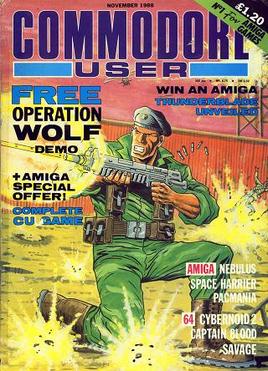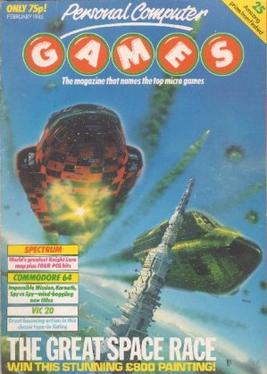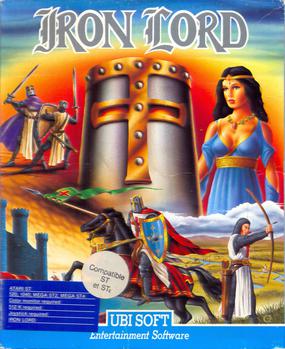
The Commodore 64, also known as the C64, is an 8-bit home computer introduced in January 1982 by Commodore International. It has been listed in the Guinness World Records as the highest-selling single computer model of all time, with independent estimates placing the number sold between 12.5 and 17 million units. Volume production started in early 1982, marketing in August for US$595. Preceded by the VIC-20 and Commodore PET, the C64 took its name from its 64 kilobytes(65,536 bytes) of RAM. With support for multicolor sprites and a custom chip for waveform generation, the C64 could create superior visuals and audio compared to systems without such custom hardware.

Jeff Minter is an English video game designer and programmer who often goes by the name Yak. He is the founder of software house Llamasoft and has created dozens of games during his career, which began in 1981 with games for the ZX80. Minter's games are shoot 'em ups which contain titular or in-game references demonstrating his fondness of ruminants. Many of his programs also feature something of a psychedelic element, as in some of the earliest "light synthesizer" programs including Trip-a-Tron.
The video game crash of 1983 was a large-scale recession in the video game industry that occurred from 1983 to 1985, primarily in the United States. The crash was attributed to several factors, including market saturation in the number of video game consoles and available games, many of which were of poor quality. Waning interest in console games in favor of personal computers also played a role. Home video game revenue peaked at around $3.2 billion in 1983, then fell to around $100 million by 1985. The crash abruptly ended what is retrospectively considered the second generation of console video gaming in North America. To a lesser extent, the arcade video game market also weakened as the golden age of arcade video games came to an end.

Commodore User, later renamed to CU Amiga, is a series of American and British magazines published by Commodore International.

In computer graphics, a sprite is a two-dimensional bitmap that is integrated into a larger scene, most often in a 2D video game. Originally, the term sprite referred to fixed-sized objects composited together, by hardware, with a background. Use of the term has since become more general.

Krome Studios Melbourne, originally Beam Software, was an Australian video game development studio founded in 1980 by Alfred Milgrom and Naomi Besen and based in Melbourne, Australia. Initially formed to produce books and software to be published by Melbourne House, a company they had established in London in 1977, the studio operated independently from 1987 until 1999, when it was acquired by Infogrames, who changed the name to Infogrames Melbourne House Pty Ltd.. In 2006 the studio was sold to Krome Studios.

Imagine Software was a British video games developer based in Liverpool which existed briefly in the early 1980s, initially producing software for the ZX Spectrum and VIC-20. The company rose quickly to prominence and was noted for its polished, high-budget approach to packaging and advertising, as well as its self-promotion and ambition.

Impossible Mission is a video game originally written for the Commodore 64 by Dennis Caswell and published by Epyx in 1984. The game features a variety of gameplay mechanics from platform and adventure games, and includes digitized speech. Impossible Mission, which casts the player in the role of a secret agent infiltrating an enemy stronghold, is widely considered one of the best games for several platforms.
Xonox, a division of K-tel Software, was an American third-party manufacturer of cartridges for the Atari 2600, ColecoVision, Commodore 64, and VIC-20 in the early 1980s. Xonox was one of many small video game companies to fold during the Video Game Crash of 1983.

Ant Attack is an action game written for the ZX Spectrum by Sandy White and published by Quicksilva in 1983. A Commodore 64 version was released in 1984.

8 Bit Weapon is an American chiptune music band formed in Ventura County, California, by Seth and Michelle Sternberger. It was originally created by Seth Sternberger around 1998. Its instruments consists primarily of old 8-bit and 16-bit computers such as the VIC-20, Commodore 64, Commodore 128, Amiga 500, and the Apple II, as well as game consoles such as the Nintendo Entertainment System, Game Boy, Atari 2600, and an Intellivision synthesizer.

The Commodore 64 home computer used various external peripherals. Due to the backwards compatibility of the Commodore 128, most peripherals would also work on that system. There is also some compatibility with the VIC-20 and Commodore PET.

Personal Computer Games was a multi-format UK computer games magazine of the early/mid-1980s published by VNU.
Alligata Software Ltd. was a computer games developer and publisher based in Sheffield in the UK in the 1980s.

Iron Lord is an adventure video game developed by Orou Mama and Ivan Jacot for the Atari ST and published by Ubi Soft in 1989. It was ported to the Amiga, Acorn Archimedes, Amstrad CPC, Commodore 64, ZX Spectrum, and MS-DOS.

Snake Byte is video game written by Chuck Sommerville for the Apple II and published by Sirius Software in 1982. The game is a single-player variant of the snake concept. It was released the same year for Atari 8-bit computers and on cartridge for the VIC-20. A Commodore 64 version followed in 1983.

Suzy Soft was a Yugoslav video game publisher active during the 1980s, operating in Croatia. It started in 1985 as the software division of Suzy Records, based in Zagreb, and published video games and programs for ZX Spectrum, Commodore 64 and Orao by various Yugoslav developers. It was the first Yugoslav company dedicated to software publishing. The house became defunct in 1988, as its parent ditched the software publishing department.













